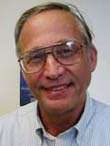Today
Noon
Yoga Club
Yoga with Inna Belogolovsky
Bldg. 70-191
Noon
Dance Club
Beginning East Coast Swing Lesson
Bldg. 51 Lobby
3:45 p.m.
Nuclear Engineering
Computational Safety: In Silico Evolution of Nuclear Power
Truc-Nam Dinh, Royal Institute of Technology, Sweden
3105 Etcheverry Hall
4 p.m.
Chemistry
Structural and Quantitative Biology Seminar
Wayne Hendrickson, Harvard U.
105 Stanley Hall
4:30 p.m.
Physics
Fluorescence Mapping of Microbes in Polar Ice: What We are Learning About Metabolism at Low-Temperature and the Archaeology of Storms
Buford Price, UC Berkeley
1 LeConte
Tomorrow
11 a.m.
Chemistry
Chiral Cations for Enantioselective Synthesis, Pathways and Applications
Elias Corey, Harvard U.
120 Latimer Hall
11 a.m.
CITRIS
Freedom From Oil
David Sandalow, Brookings Institute
290 HMMB
4 p.m.
Life Sciences and Genomics
Can Over-Cooked Food Contribute to Your Cancer Risk? A Mechanistic Understanding
James Felton, Livermore Lab
Bldg. 66
4 p.m.
Chemistry
Ion Formation, Dissociation and Reaction in the Ambient Environment
Graham Cooks, Purdue U.
120 Latimer Hall
|
|
 |
|
|
 |
|
| |
Breakfast: Garden Flats Scramble Wrap with Hash Browns
Tomorrow's Breakfast: Breakfeast Burrito with Beans
Pizza: Italian Hero
Grill: French Dip with Garlic Fries
Deli: Ham & Swiss with Spinach and Tomato on Toasted Foccacia Prestini
Carvery: Garlic Roasted Chicken with Roasted Potatoes and Vegetables
Entree: Pasta Bar with Choice of Sauce served with Salad & Garlic Bread
| B'fast: |
6:30
a.m. - 9:30 a.m. |
| Lunch: |
11
a.m. - 1:30 p.m. |
| Full
menu |
| |
|
|
|
 |
|
 |

New Device May Cure
Red Wine Headaches
By Marcus Wohlsen
|
|
|
|
 |
 |
|
|
Mathies |
|
|
|
The effects are all too familiar: a fancy dinner, some fine wine and then, a few hours later, a racing heart and a pounding headache. But a new tool could help avoid the dreaded ''red wine headache.'' Chemists — including Berkeley Lab physical bioscientist Richard Mathies — working with NASA-funded technology designed to find life on Mars have created a device they say can easily detect chemicals that many scientists believe can turn wine and other beloved indulgences into ingredients for agony. Full story.

NERSC’s Seaborg
Computer Retires
|
|
|
|
 |
 |
|
|
Seaborg computer |
|
|
|
Seaborg, the IBM supercomputer that has tackled some of the most challenging problems in astrophysics, climate research, fusion energy, chemistry and other scientific areas, is set to retire next January after seven years of serving NERSC users. At the time of its purchase, the IBM SP RS/6000 represented the largest single procurement in Berkeley Lab's history, costing $33 million for the system and a five-year contract. Named after the Nobel prize winner and Berkeley Lab chemist Glenn Seaborg, the supercomputer began its service in January 2001 and was ranked No. 2 on the June 2001 TOP500 list, a semi-annual ranking of the world's most powerful supercomputers. Full story.
Lab Shares Computing
Expertise at SC07
From Nobel Laureate George Smoot to technical papers, workshops and talks, experts from Berkeley Lab will have a strong presence at the SC07 (Supercomputing '07)
conference in Reno, NV. Nov. 10-16. "The conference is a great venue to highlight the expertise of our researchers, who are contributing to nearly 10 percent of all the papers accepted for the conference," said Horst Simon, Associate Lab Director for Computing Sciences. Full story.
 |
 |
|
 |
|
 |
November is Alzheimer’s
Awareness Month
The Health Care Facilitator’s office wants to remind employees that November is “National Alzheimer’s Disease Awareness Month.” Although symptoms of the disease can vary widely, the first problem many notice is forgetfulness severe enough to affect work, hobbies or social life. As the disease progresses, other symptoms include confusion, trouble with organizing and expressing thoughts, misplacing things, getting lost in familiar places, and changes in personality and behavior. An early diagnosis helps individuals receive treatment and may allow them to take part in decisions about care, living arrangements, money and legal matters.
Veterans Day
Holiday Option
Eligible employees have the option of using Veterans Day, Monday, Nov. 12, as a paid holiday (if they have not already taken Cesar Chavez Day as a holiday) with approval from a supervisor. Those who do, however, must use a third vacation day on Wednesday, Dec. 26. See the "Limited Floating Holiday Implementation Guidance" website for information on eligibility and time entry procedures. Laboratory policy concerning holidays is contained in the Regulations and Procedures Manual (RPM), Section 2.10. Go here to view the Lab's full holiday schedule.
 |  |
|
|
 |
|
|
|
|
 EMERGENCY INFO EMERGENCY INFO |
 |
Emergency: Call x7911
Cell Phones: Call 911
Non-emergency Incident Reporting: Call x6999
SECON level 3
More Information |
 |
|
|
 |
|
|

